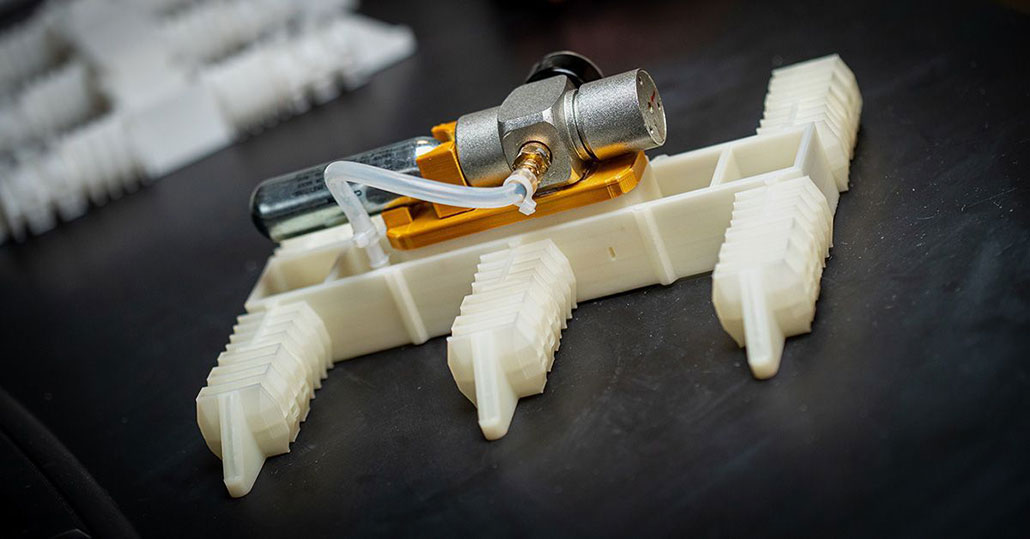This 3-D printed robot runs on air, not electricity
The soft robot can cross uneven terrain and even walk underwater

This 3-D printed robot doesn’t need electronics. Instead, it uses an air canister to move.
David Baillot/University of California, San Diego
Share this:
- Share via email (Opens in new window) Email
- Click to share on Facebook (Opens in new window) Facebook
- Click to share on X (Opens in new window) X
- Click to share on Pinterest (Opens in new window) Pinterest
- Click to share on Reddit (Opens in new window) Reddit
- Share to Google Classroom (Opens in new window) Google Classroom
- Click to print (Opens in new window) Print
By Skyler Ware
A new air-powered robot can practically walk right off the 3-D printer.
The soft, 3-D printed robot doesn’t have any electronic parts. All it needs to move is an air canister. One day, robots like this could work underwater or in hazardous environments, its creators say.
Mechanical engineer Yichen Zhai led the work. He and his colleagues at the University of California, San Diego, gave their robot six flexible legs, like an insect. Each leg can move up and down or side to side. The whole thing is made from the same type of plastic that’s used to make hoses and shoe soles. The scientists 3-D printed it in one piece over the course of two and a half days.
Air from a canister flows through tiny tubes and chambers in the robot’s body to power it. As the pressure in each of these chambers changes, it opens and closes different tubes. That moves air into different sets of chambers, and the process starts again. This cycle of inflating and deflating chambers moves the robot’s legs to waddle forward.
Researchers published the design in the May issue of the journal Advanced Intelligent Systems.
The robot’s design is “quite interesting,” says Perla Maiolino. She wasn’t involved in building it, but she does work on other soft robots at the University of Oxford in England. Typically, making a robot involves designing different parts from different substances and assembling them, she says. But this one’s body is a single piece made with just one material. “It’s all together.”
The robot may be soft, but its shape actually makes it quite sturdy. Having six legs helps it stay upright on rough and uneven ground. Whenever it takes a step, three of its legs move at once while the other three stay on the ground. This way, it doesn’t tip over easily. And because the design doesn’t contain any electronics, it’s waterproof. In experiments on the beach, the robot toddled right down into a deep puddle and resurfaced to continue along its way.
Electronics-free robots could one day work in areas that would thwart regular ones. “We are really pushing toward having untethered robots that can be deployed in very harsh environments,” Maiolino says. An “untethered” robot is one that doesn’t need to be connected to a power cord or controller.
A robot like the new six-legged walker could work in areas where electronics might be a fire risk, such as in mines. Or it might be used in space, where radiation could harm delicate electronic components.
But the new soft robot isn’t quite ready for these harsh conditions yet. The robot has to be able to move faster first, says Zhai. That will let it move farther on a single air canister. As of now, the insect-like robot creeps along at a leisurely pace of 4 centimeters (1.6 inches) per second. That’s a little faster than a snail, but slower than a turtle. A single canister of air can power it for about 80 seconds.
Zhai and his colleagues are currently building a faster version of their machine. The team also hopes to add a steering system or a way for the robot to dodge obstacles. Right now, it can only shuffle forward in a straight line. Controlling air flow through the robot could allow it to change direction in response to obstacles — sort of like a self-driving Roomba vacuum.
Until the robot gets these upgrades, it won’t be doing heavy-duty work. But in its current form, people can still enjoy interacting with it. “The robot is like a toy,” Zhai says. And it can be cheaply and easily 3-D printed. “If people love it, people can make it,” he says. “That’s enough.”
Do you have a science question? We can help!
Submit your question here, and we might answer it an upcoming issue of Science News Explores







